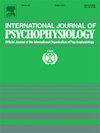颞叶癫痫患者面部情绪知觉受损的脑电图表现
IF 2.5
3区 心理学
Q3 NEUROSCIENCES
引用次数: 0
摘要
目的探讨颞叶和枕颞皮质区对面部情绪知觉的影响。FEP可能由事件相关的脑振荡表征。在颞叶癫痫(TLE)患者中,行为和功能神经成像(FMRI, PET, MEG)显示FEP损害,但未显示事件相关振荡,这是一种众所周知的认知研究方法。本研究旨在通过分析脑电图事件相关的θ波振荡来探讨TLE患者的FEP。方法选取21例TLE患者和19例健康志愿者。在EEG记录过程中,使用了来自Ekman和Friesen的照片系列中的15张照片,这些照片显示了五种不同的面部表情(愤怒、快乐、中性、恐惧、悲伤)。利用Brain Vision Analyzer程序,采用小波变换方法对事件相关θ (3 ~ 8hz)功率谱和锁相进行分析。结果TLE患者与健康志愿者在theta功率上有显著性差异(P <;0.05),但左、右TLE患者间无显著差异(P >;0 05)。与健康志愿者相比,患者组所有面部的θ波功率都较低,尤其是在颞顶叶和顶叶区域(P <;0 05)。左侧TLE患者在快乐面部表情上显著受损,右侧TLE患者在恐惧面部表情上显著受损。结论TLE患者FEP受损的特征是事件相关θ波反应下降,尤其是颞顶叶和顶叶区。本研究在文献中首次提出了TLE患者FEP受损的电生理指标。目前的研究可以为未来与认知任务和癫痫相关的神经网络研究提供指导。本文章由计算机程序翻译,如有差异,请以英文原文为准。
Demonstration of impaired facial emotion perception in temporal lobe epilepsy by theta responses in EEG
Objective
Temporale lobe and occipito-temporal cortical areas play an important role in facial emotion perception (FEP). FEP might be represented by event-related brain oscillations. In patients with temporal lobe epilepsy (TLE), impairment of FEP was shown with behavioral and functional neuroimaging (FMRI, PET, MEG) but not event-related oscillations, which is a well known method for cognitive research studies. The present study aims to explore FEP by analyzing EEG event-related theta oscillations in patients with TLE.
Methods
21 patients with TLE and 19 healthy volunteers were included. During EEG recording, 15 photographs from Ekman and Friesen's photo series showing five different facial expressions (angry, happy, neutral, fearful, sad) were used. Event-related theta (3–8 Hz) power spectrum and phase locking were analyzed by wavelet transform method using the Brain Vision Analyzer program.
Results
The difference between TLE patients and healthy volunteers was found to be significant for theta power (P < 0,05), but there was no significant difference between right and left TLE patients (P > 0,05). Lower theta power was observed against all faces in the patient group, especially in temporo-parietal and parietal areas, compared to healthy volunteers (P < 0,05). Patients with left TLE were significantly impaired in happy facial expressions, patients with right TLE were significantly impaired in fearful facial expressions.
Conclusions
Impaired FEP in patients with TLE is characterized by decreased event-related theta responses, particularly in temporo-parietal and parietal areas. The present study presents the electrophysiological indicators of impaired FEP in TLE patients for the first time in the literature. The current study could be a guide for future research related to neural networks in cognitive tasks and epilepsy.
求助全文
通过发布文献求助,成功后即可免费获取论文全文。
去求助
来源期刊
CiteScore
5.40
自引率
10.00%
发文量
177
审稿时长
3-8 weeks
期刊介绍:
The International Journal of Psychophysiology is the official journal of the International Organization of Psychophysiology, and provides a respected forum for the publication of high quality original contributions on all aspects of psychophysiology. The journal is interdisciplinary and aims to integrate the neurosciences and behavioral sciences. Empirical, theoretical, and review articles are encouraged in the following areas:
• Cerebral psychophysiology: including functional brain mapping and neuroimaging with Event-Related Potentials (ERPs), Positron Emission Tomography (PET), Functional Magnetic Resonance Imaging (fMRI) and Electroencephalographic studies.
• Autonomic functions: including bilateral electrodermal activity, pupillometry and blood volume changes.
• Cardiovascular Psychophysiology:including studies of blood pressure, cardiac functioning and respiration.
• Somatic psychophysiology: including muscle activity, eye movements and eye blinks.

 求助内容:
求助内容: 应助结果提醒方式:
应助结果提醒方式:


